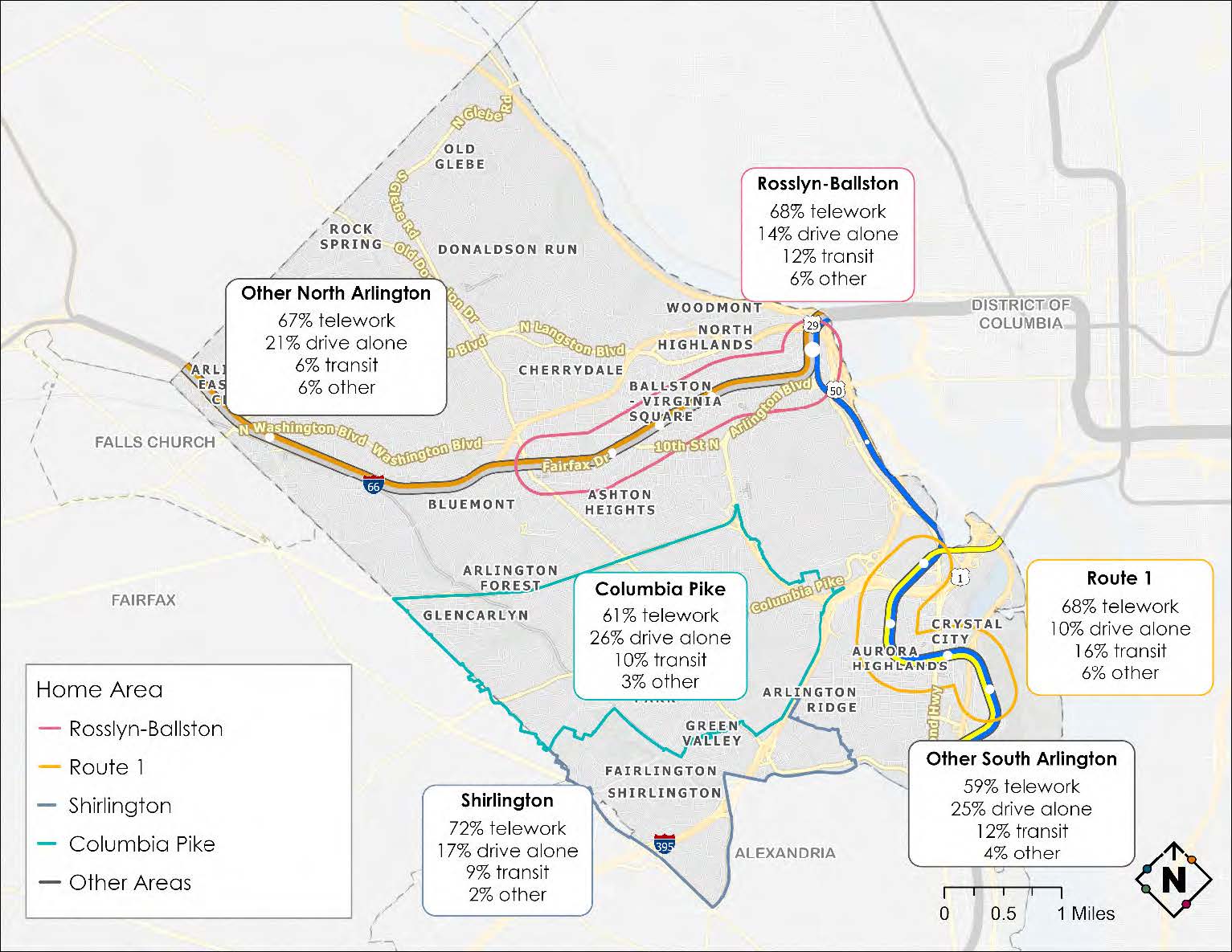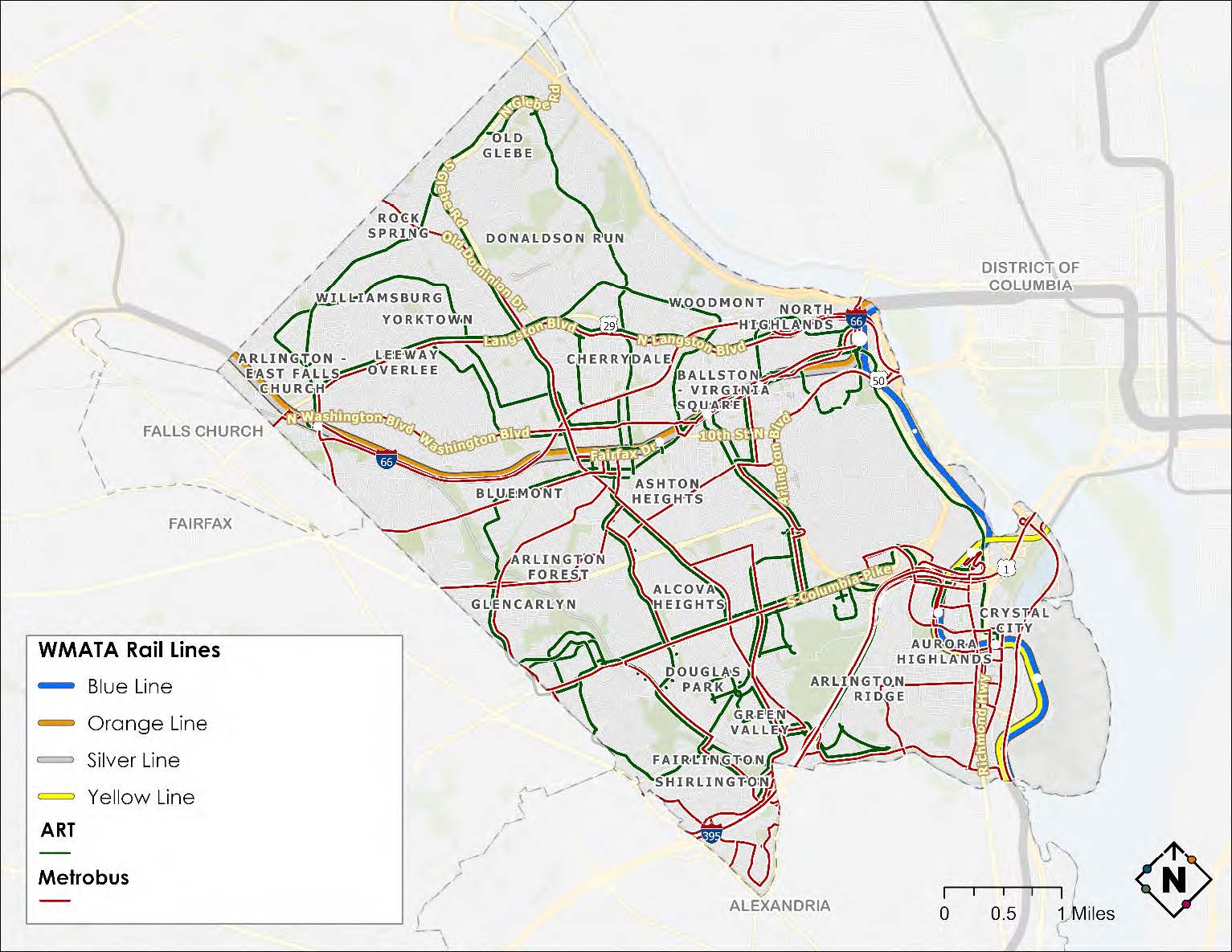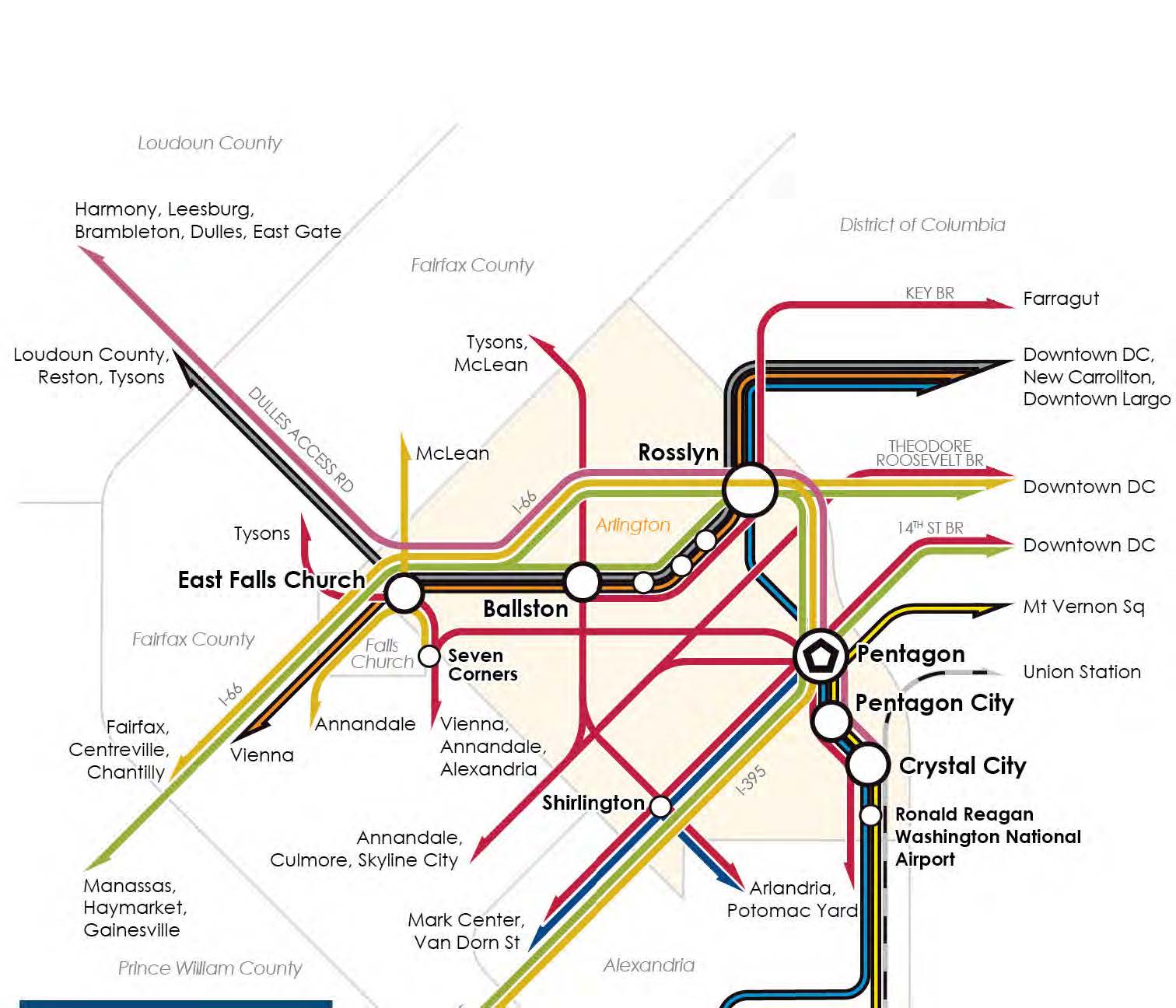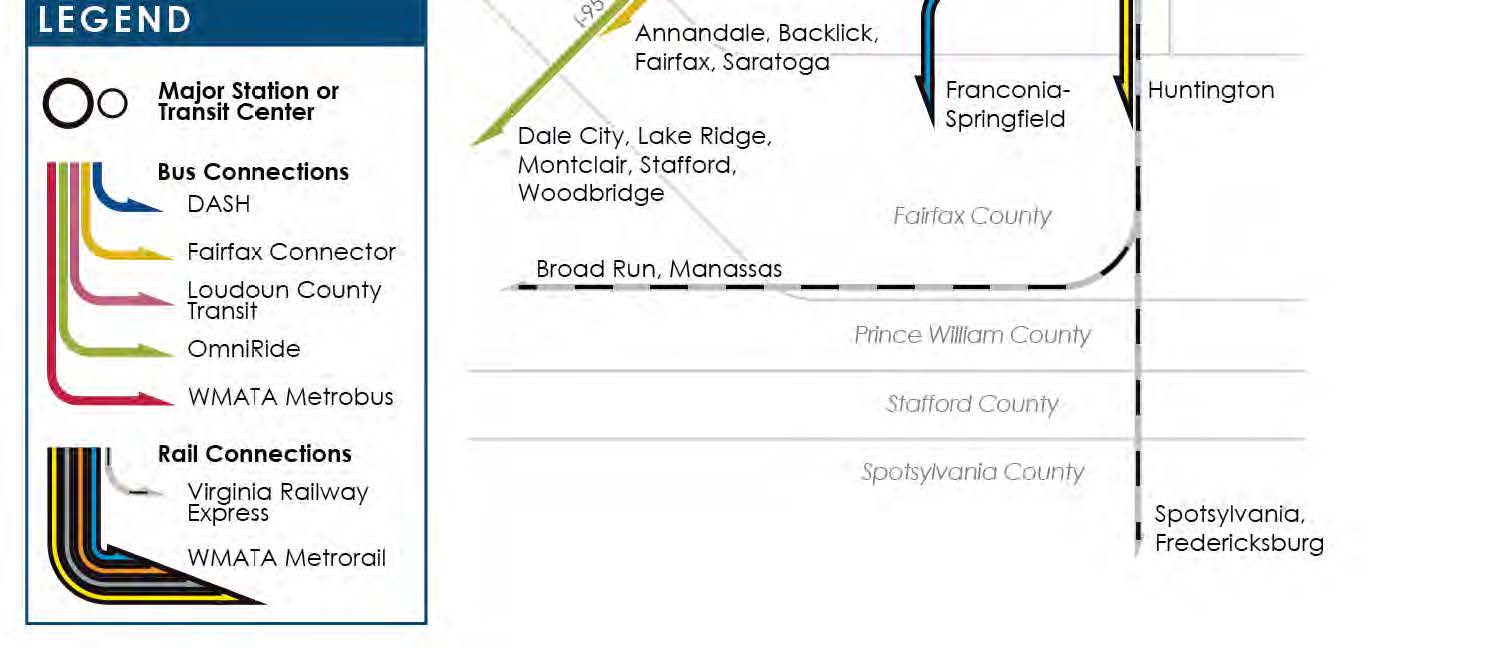Chapter 2, Part 3, ACCS Strategic Plan
This text-only version is offered as a more accessible alternative to this PDF document: Arlington County Commuter Services Transportation Demand Management Plan (PDF, 3.85 MB).
Table 10: Commute and Non-Commute Mode Share (2021 Arlington Resident Travel Survey)
|
Trip Type |
Drive alone, Taxi, Ride-hail |
Train |
Bus |
Personal bike, Bikeshare, Scooter |
Walk |
Carpool/ Vanpool |
Telework |
||||
|
Commute Trips |
|||||||||||
|
% of Weekly Commute Trips Made During Past Week |
20.2 |
7.2 |
2.9 |
2.3 |
2.2 |
0.6 |
64.6 |
||||
|
Non-commute Trips |
|||||||||||
|
% of Respondents Who Used Mode During Past Week (Weekday or Weekend)* |
74 |
1 |
14 |
20 |
10 |
13 |
3 |
2 |
48 |
27 |
- |
|
*Multiple responses permitted, so responses do not total 100%. |
|||||||||||
Figure 11: Commute Mode Share by Home Area (2021 Arlington Resident Travel Survey)

Figure 12: Weekly Commute Trips by Mode (2015 and 2021 Arlington Resident Travel Survey)

American Community Survey (ACS)
Table 11 includes commute mode share data from the American Community Survey's (ACS) Five-Year Estimates (2021) as well as its One-Year Estimates (2022), 21 which more closely reflect current post-pandemic telework patterns.22 This data shows commute mode shares of 39 to 44 percent driving alone, 25 to 35 percent non-SOV modes, and 21 to 36 percent telework—a much lower estimate than the 2021 Arlington Resident Travel Survey which revealed a 65 percent telework mode share.
Table 11: Commute Mode Share (American Community Survey)
|
Source |
Drive alone |
Carpool |
Transit |
Bicycle |
Walk |
Other |
Telework |
|
Five-year Estimates (2021) |
43.8% |
5.8% |
21.6% |
1.5% |
4.6% |
1.6% |
21.3% |
|
One-year Estimates (2022) |
39.0% |
5.3% |
12.2% |
1.0% |
3.9% |
2.7% |
35.8% |
Location-Based Services Data
Table 12 includes commute mode share data from Replica, a data platform that provides an interpolation of travel flows via a seasonal mobility model based on mobile device location data, consumer/resident data, built environment data, economic activity data, and ground truth data.23 Because Replica only estimates trips based on movement, teleworking is not included as a mode option. Replica data reveal commute mode splits of:
21 Source: American Community Survey (ACS) Five-Year Estimates (2021) and One-Year Estimates (2022), Table B08006.
22 While one-year estimates reflect more current data, they are less precise because they use a smaller sample over just one year.
23 The cited mode splits are derived from Replica's Spring 2023 model, which was customized for Arlington-related trips. More detailed information about the source data, methodology, and outputs of Replica's seasonal mobility model can be found at https://documentation.replicahq.com/docs/seasonal-mobility-model-methodology-summary-places
-
33 percent transit/walk/bike/other, 16 percent auto passenger, and 51 percent drive alone/taxi/ride-hail for Arlington residents commuting within Arlington.
-
19 percent transit/walk/bike/other, 30 percent auto passenger, and 51 percent drive alone/taxi/ride-hail for Arlington residents commuting outside Arlington.24
-
14 percent transit/walk/bike/other, 37 percent auto passenger, and 49 percent drive alone/taxi/Transportation Network Company (TNC, i.e., Uber or Lyft) for regional residents25 outside Arlington commuting to Arlington.
Table 12 also includes non-commute mode share data from Replica:
-
Arlington residents' non-commute trips are 28 percent transit/walk/bike/other, 27 percent auto passenger, and 44 percent drive alone/taxi/ride-hail.
-
Arlington residents' total trips (commute and non-commute) are 27 percent transit/walk/bike/other, 27 percent auto passenger, and 46 percent drive alone/taxi/ride- hail.26
Since mode splits vary across different parts of Arlington County, the CAP Strategic Plan incorporates an understanding of the available options for different locations of travel to and within Arlington County.
Table 12: Commute and Non-Commute Mode Share: Location Based Services (Replica) Data
|
Demographic |
Auto driver |
Taxi/TNC |
Auto passenger |
Transit |
Bicycle |
Walk |
Other |
|
Commute trips |
|||||||
|
Arlington resident commuters to Arlington (internal Arlington) |
48.8% |
2.3% |
16.4% |
7.4% |
2.8% |
21.8% |
0.5% |
|
Arlington resident commuters to region outside Arlington |
44.4% |
6.8% |
29.8% |
11.6% |
1.3% |
5.6% |
0.5% |
|
Regional resident commuters outside Arlington to Arlington |
45.1% |
3.6% |
36.9% |
8.0% |
1.0% |
4.9% |
0.5% |
|
Non-commute trips |
|||||||
|
Arlington residents traveling within region (including Arlington) |
42.9% |
1.2% |
27.5% |
1.5% |
3.3% |
21.8% |
1.9% |
|
All trips |
|||||||
|
Arlington residents traveling within region (including Arlington) |
43.6% |
2.1% |
26.9% |
3.5% |
2.9% |
19.2% |
1.7% |
Services and Facilities
Arlington has a comprehensive transportation network comprised of County-operated transit services, regional/connecting transit services, bicycle and pedestrian infrastructure, and
24 Defined as the jurisdictions in the Metropolitan Washington Council of Governments (MWCOG) region, excluding Arlington.
25 Defined as the MWCOG jurisdictions, excluding Arlington.
26 Source: Replica data, Q2 2023.
roadway facilities to support both the local and regional travel needs of Arlington residents, workers, and visitors.
ARLINGTON COUNTY TRANSIT SERVICES
The Arlington County Department of Environmental Services' Transit Bureau oversees transit operations and provides transit services to accommodate the needs of County residents, employees, and visitors, namely through the services outlined below. The services described in this section are shown in Figure 13.27
Figure 13: Arlington County Transit Services

Arlington Transit (ART)
ART is Arlington's local bus service, providing service to most neighborhoods in the County. Its bus route network serves some of the County's busiest corridors and complements the Washington Metropolitan Area Transit Authority's (WMATA) Metrorail and Metrobus services to provide additional connections between key destinations. ART operates 14 routes, seven of which operate seven days per week, and four of which provide all-day frequency of every 20 minutes or better. These higher frequency routes are located mostly along the Rosslyn-Ballston corridor, Columbia Pike, Langston Boulevard, and Glebe Road, and near Metrorail stations.
ART also serves several high-profile federal agencies and facilities, such as the Pentagon, Transportation Security Administration (TSA), US Marshals Service, US State Department, and the Defense Advanced Research Projects Agency (DARPA). The transit service network includes the Shirlington Bus Station, the only enclosed public bus station in Arlington and the principal transfer point for ART, Metrobus, and DASH bus service from Alexandria. The Pentagon Transit Center and Ballston Transit Hub are two other major transit transfer locations in Arlington.
Specialized Transit for Arlington Residents (STAR)
STAR is the County's designated Americans with Disabilities Act (ADA) paratransit service. This service is provided to Arlington residents who are not able to use fixed-route transit due to a qualifying disability. It offers curb-to-curb service for residents eligible for WMATA's MetroAccess service.
STAR is available between 5:30 a.m. and midnight, seven days a week. All peak period, night, and weekend trips must begin or end in Arlington. This service is intended to provide a comparable level of transportation to that provided by ART, Metrobus, and Metrorail.
REGIONAL TRANSIT SERVICES IN ARLINGTON
Arlington is also served by regional transit providers, as outlined below.
Washington Metropolitan Area Transit Authority (WMATA)
WMATA provides regional bus and rail transit service between and within various localities across the Washington, DC metropolitan area, including Arlington.
Metrorail
Metrorail is WMATA's heavy rail service that includes 11 stations within Arlington served by the Yellow, Blue, Orange, and Silver Lines.
Metrorail service runs on all lines from 5:00 a.m. to midnight, Mondays through Thursdays; 5:00 a.m.–1:00 a.m. on Fridays; 7:00 a.m.–1:00 a.m. on Saturdays; and 7:00 a.m. to midnight on Sundays. As of August 2024, Metrorail trains run approximately every six to eight minutes on the Yellow Line and every 10 to 15 minutes on the Blue, Orange, and Silver Lines. Due to the lines sharing alignments in most of Arlington, effective service frequencies along Arlington's Metrorail corridors are higher than the individual line frequencies would suggest.
Metrobus
Metrobus is WMATA's bus service that provides coverage in the District of Columbia, Maryland, and Virginia. Arlington's Metrobus service provides connections to major regional destinations and/or Metrorail stations.
Metrobus service generally operates from 5:00 a.m. to midnight on weekdays and Saturday and from 6:00 a.m.–11:00 p.m. on Sundays. Some routes begin service as early as 4:00 a.m. and run as late as 3:00 a.m. Metrobus' frequent routes run every 12 to 20 minutes or better from 7:00 a.m.–9:00 p.m. daily, with less frequent service during early morning and late-night times. Metrobus also operates local, commuter, and limited-stop service at varying days, times, and service levels. Weekday service frequencies range between 10 and 60 minutes, while weekend service operates at frequencies between 12 and 60 minutes.
Metroway
Metrobus service also includes Metroway, a Bus Rapid Transit (BRT) line also known as the Potomac Yard Line. It operates between Pentagon City in Arlington and Braddock Road in Alexandria. Metroway operates partially within bus-only guideways.
Metroway service runs from 5:30 a.m.–10:00 p.m. Mondays through Thursdays; 5:30 a.m. to midnight on Fridays; 6:30 a.m. to midnight on Saturdays; and 7:30 a.m.–10:00 p.m. on Sundays. During peak hours, Metroway buses run every six minutes from Crystal City to Potomac Yard and every 12 minutes between Braddock Road and Pentagon City. Buses run every 12 minutes during daytime off-peak hours, every 15 minutes in the evening off-peak hours, and every 20 minutes on weekends.
Columbia Pike Premium Transit Network
Arlington County is implementing premium transit service along Columbia Pike, connecting Columbia Pike, Pentagon City, and Crystal City, as part of the planned Premium Transit Network (PrTN). The first phase of improvements was implemented in 2018 and included the restructuring of a Metrobus route with a net increase in service, Metrobus schedule improvements, and an updated “Pike Ride” logo. The planned PrTN, including Columbia Pike, will include high-quality transit stations with near-level boarding and real-time bus arrival information, off-vehicle fare collection, transit signal priority, and branded vehicles. The PrTN is and will continue to be used by both Metrobus and ART routes.
MetroAccess
WMATA provides MetroAccess ADA paratransit service to complement the local and regional rail and bus network. To use MetroAccess, riders must meet the criteria specified under the Americans with Disabilities Act (ADA). Eligibility is based on a person's functional limitations and not whether they have a disability or based on their age. The service area includes the District of Columbia, Montgomery County, Prince George's County, Arlington County, Fairfax County, and the cities of Alexandria, Fairfax, and Falls Church.
Core hours of MetroAccess operation mirror the core service hours of Metrorail and Metrobus. Reservations can be made for service outside those hours if fixed-route service is offered at the same time along the requested route of MetroAccess travel.
OTHER CONNECTING TRANSIT SERVICES
In addition to ART and regional transit services, Arlington is served by several transit agencies of adjacent jurisdictions, as shown in Figure 14.28
28 Service shown current as of October 2024.
Figure 14: Arlington County External Transit Connections


Virginia Railway Express (VRE)
VRE is the commuter rail service connecting the Northern Virginia suburbs along the Interstate 95 and Interstate 66 corridors from Fredericksburg and Manassas to Alexandria, Arlington (Crystal City), and L'Enfant Plaza and Union Station in Washington, DC.
The only VRE station in Arlington is the Crystal City station located on South Crystal Drive, about five miles south of Union Station. The combined headway of both the Fredericksburg and Manassas lines provides Crystal City with 14 northbound trains to Union Station between 6:00– 9:30 a.m. and 15 southbound trains between 1:00–7:30 p.m. VRE service at the Crystal City station is northbound-only in the morning and southbound-only in the afternoon and operates on weekdays only.
Connections to other modes from the Crystal City VRE station are possible, namely to the Metrorail Crystal City station (Yellow and Blue Lines), Metroway, Metrobus (Routes 23A and 23B), and ART (Route 43).
DASH
DASH is the bus service operated by the City of Alexandria. The system has 11 routes, several of which terminate at major transfer points in Arlington County. Route 36A/B terminates at the Shirlington Bus Station while Routes 35, 103, and 104 terminate at the Pentagon Metro station.
Fairfax Connector
Fairfax Connector, operated by Fairfax County, is the largest local bus system in Northern Virginia. The system has 91 routes, several of which provide service into and/or through Arlington County, connecting at the East Falls Church, Pentagon, Pentagon City, and Crystal City Metro stations.
Loudoun County Transit
Loudoun County provides several transit services both within and outside its county limits, including several commuter routes into Washington, DC, that stop in Arlington County at Rosslyn, Crystal City, and the Pentagon. Loudoun County Transit commuter routes serving Arlington County operate on weekdays only.
Omni-Ride
Omni-Ride is the operating name for the mobility services offered by the Potomac and Rappahannock Transportation Commission in the Prince William County area. Omni-Ride services include several express bus routes into Washington, DC with stops in Arlington County at Ballston, Rosslyn, Crystal City, and the Pentagon. Omni-Ride express routes serving Arlington County operate on weekdays only.
WALKING, BIKING, AND ROLLING MODES
Arlington provides a variety of infrastructure and programming to support walking, biking, and rolling. A map of Arlington County's bicycle facilities and Capital Bikeshare station locations as of January 2024 is provided in Figure 15.29
29 Bicycle facilities and Capital Bikeshare stations current as of January 2024.
Figure 15: Arlington County Bicycle Facilities and Capital Bikeshare Stations

Walking
Arlington has a high-quality pedestrian network and has been designated as a platinum-level Walk Friendly Community due to its emphasis of growth around transit lines, Vision Zero efforts, Complete Streets program, ACCS's PAL (Predictable, Alert, Lawful) campaign for sharing the street with others, and several other factors.30 Approximately 90 percent of residential streets in Arlington have sidewalks. Arlington's goal is to design sidewalks to be safe from conflicts with vehicular traffic and to provide easy access to mixed-use destinations.
All new construction in Arlington is built to ADA standards. Additionally, the County has retimed traffic signals to improve pedestrian safety at intersections. The Pedestrian Element of the Arlington Master Transportation Plan (MTP) focuses on pedestrian travel, which is affected by land use, street design, and transportation system management. Arlington also has nearly 50 miles of paved multi-use trails for walking and biking.
Bicycling
Arlington's emphasis on mixed-use development and its compact size produces many short trips for which bicycling is an effective travel mode. In addition to its over 50 miles of paved trails, the County has over 25 miles of on-street bike lanes, protected bike lanes, shared lane markings, and on-street bike routes. Bicycle and pedestrian count data from 2022 along the Custis Trail, Mount Vernon Trail, and W&OD Trail showed between 400,000 and 600,000 annual bicycle and pedestrian trips at each location, and over 1,200,000 annual bicycle and pedestrian trips crossing the Key Bridge between Arlington (Rosslyn) and the District of Columbia.
Both ART and Metrobus have bicycle racks on their buses that can accommodate two standard length bicycles. Bikes are permitted on Metrorail at no additional cost, with Metro having the right to restrict bicycle access during special events or high passenger volume. Bike racks are also provided outside each Metrorail station.
As part of the special development approval process, ACCS's TDM for Site Plans program works with developers and Arlington County Public Schools to incorporate bicycling infrastructure, such as secure bike parking facilities, visitor bike parking, showers, and lockers, into new or renovated developments and schools at the time of construction. This increases the availability, awareness, and use of biking as a travel option.
The Bicycle Element of the Arlington MTP focuses on bicycle travel, which is affected by land use, street design, traffic volumes, fuel prices, public perception, and transportation system management.
Capital Bikeshare
For short point-to-point bicycle trips, Capital Bikeshare, one of the largest and most successful public bikeshare systems in North America, has 111 stations in Arlington County, as shown in Figure 15. Capital Bikeshare stations are concentrated in the Rosslyn-Ballston Corridor, Crystal City, Columbia Pike, Shirlington, Langston Boulevard, and Pentagon City areas. Its fleet includes classic pedal bikes and, as of 2023, new dockless e-bikes, which are being deployed in Arlington and other jurisdictions.
Capital Bikeshare completed its thirteenth fiscal year of service in Arlington in June 2023. Ridership continues to strengthen after a COVID-19 pandemic dip. In FY 2023, ridership returned to pre-pandemic levels, with 266,036 trips starting in Arlington (up 25 percent from FY 2022). FY 2023 also saw 1,905 Arlington-based registered annual customers, which was slightly down from FY 2022 which had 1,931 registered annual customers.31
Shared Micromobility Devices
Arlington has adopted a shared micromobility device permit program to promote and regulate the use of this technology to support connections to other transit modes throughout the county. Arlington considers a micromobility device to be any type of motorized vehicle that can be classified as a pedal bike, electric power assisted bike (e-bike), motorized scooter
31 Source: https://www.bikearlington.com/wp-content/uploads/2023/12/FY23-CaBi-Summary-Report_.pdf
(e-scooter), or motorized skateboard. As of 2024, Bird, Lime and Spin have been authorized to supply shared micromobility devices within Arlington.
ROADWAYS AND VEHICULAR-BASED OPTIONS
Arlington County is served by a comprehensive network of local streets, collectors, arterials, and expressways. Non-SOV trips are accommodated on Arlington's roadways through a variety of infrastructure and services, as outlined below.
Carpooling
ACCS works closely with programs such as The Commuter Store® and Arlington Transportation Partners to promote, coordinate, and facilitate use of carpooling for trips both within the County as well as throughout the DC region. This service is vital for reducing congestion on the roadway network and improving quality of life through reduced travel times and improved air quality.
Vanpooling
ACCS refers riders and local employers who are interested in vanpooling to local providers. Vanpool services are similar to carpools, except vanpools can accommodate four to 15 passengers and must use a vehicle having at least seven seats. Vanpool program participants can also pay for their ride with a transit benefit, as the federal government considers vanpools a form of transit.
Guaranteed Ride Home (GRH)
The Metropolitan Washington Council of Governments (MWCOG) administers this program, which provides registered commuters who regularly take transit, bike, walk, or carpool/vanpool to work with a free reliable ride home for emergencies or unscheduled overtime. This service can be used by registered commuters up to four times per year.
Transportation Network Companies (TNCs)
Transportation Network Company (TNC) service is available in Arlington. TNCs are companies such as Uber or Lyft that use an online platform to connect passengers with drivers using their personal vehicles. TNC services operate much like a taxi but provide the ability to immediately reserve trips on-demand and book and pay for door-to-door travel with a geolocated mobile application. The UberPool service allows TNC passengers to reduce fares by sharing trips with other riders traveling in the same direction, similar to carpooling.
Not yet operating within Arlington, the company Via provides an additional service model that uses technology to facilitate the private operation of agency-supported on-demand and deviated-route service. TNCs in Arlington are not regulated by the County but by the Virginia Department of Motor Vehicles.
Express Lanes
Arlington has two Express Lane facilities that are owned, operated, and maintained by others. Both sets of Express Lanes use E-ZPass and E-ZPass Flex to administer tolls.
-
Interstate 66 inside the Beltway (including in Arlington) is designated as Express Lanes during the morning and afternoon rush hours, where a toll is administered for solo drivers, and those traveling with three or more people are exempt from the toll.
-
Similarly, the entire Virginia alignment of Interstate 395 (including in Arlington) has Express Lanes in addition to its regular (non-tolled) lanes. Solo drivers can use the Express Lanes by paying a toll, while those traveling with three or more people are exempt from the toll.
Park-and-Ride
A park-and-ride lot is available at the East Fall Church Metro station, where drivers can transfer to Metrorail to complete their trip into or through Arlington.
This text-only version is offered as a more accessible alternative to this PDF document: Arlington County Commuter Services Transportation Demand Management Plan (PDF, 3.85 MB).